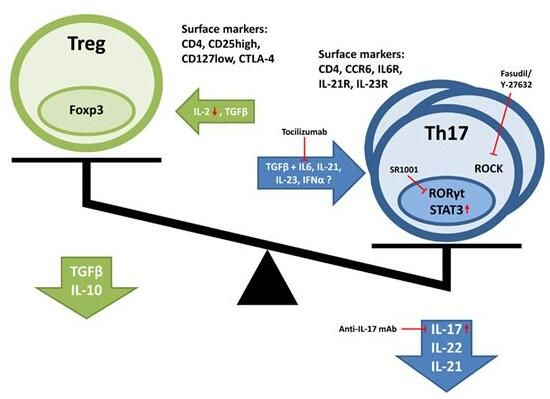调节T细胞(regulatory T cell,Treg):是一群具有负调节机体免疫反应的淋巴细胞,通常起着维持自身耐受和避免免疫反应过度损伤机体的重要作用,但也参与肿瘤细胞逃避机体免疫监视和慢性感染。

70年代曾命名为抑制T细胞(suppressor T cell),因缺乏明确的表面标志,研究长期处于尴尬和停顿的境地;直到90年代研究出现转机并成为目前研究热点,但现多称为调节T细胞(regulatory T cell)。
调节性T细胞最重要的分子标记是一种转录因子Foxp3,在所有调节性T细胞中均可发现有多量表现。
亚群
调节T细胞是免疫系统的重要组成成分,可抑制其他免疫细胞的免疫反应。这是免疫系统之中重要的“自检”组分,可防止产生过激的免疫反应。调节T细胞有多种形式,但被了解的最透彻的是表达CD4、CD25及FOXP3调节T细胞(CD4+CD25+调节T细胞)。调节T细胞与辅助T细胞不同。另一类调节T细胞亚群是Treg17细胞。调节T细胞参与到成功清除入侵生物后关闭免疫反应之中,同时也防止产生自身免疫反应。
CD4+ Foxp3+ CD25(high) regulatory T cells have been called "naturally occurring" regulatory T cells to distinguish them from "suppressor" T cell populations that are generated in vitro. Additional regulatory T cell populations include Tr1, Th3, CD8+CD28-, and Qa-1 restricted T cells. The contribution of these populations to self-tolerance and immune homeostasis is less well defined. Foxp3 can be used as a good marker for mouse CD4+CD25+ T cells, although recent studies have also shown evidence for Foxp3 expression in CD4+CD25- T cells. In humans, Foxp3 is also expressed by recently activated conventional T-cells and thus does not specifically identify human Tregs.
调节/抑制T细胞有很多种,可分为自然存在与诱导产生两类:
自然存在:
CD4+ CD25+T细胞:在维持机体对自身抗原的耐受中扮演重要角色,是目前研究最广泛深入的一种调节/抑制T细胞。
诱导产生:
TR1细胞:以分泌IL-10为特征,负调节免疫应答。
TH3细胞:最早在口服免疫耐受性动物模型中发现,以分泌转化生长因子-β(TGF-β)作为其功能性细胞激素。研究显示可能与口服免疫耐受性、黏膜免疫机制有关。
复制本文链接 文章为作者独立观点不代表本网站立场,未经允许不得转载。

 京公网安备
11010802036058号
京公网安备
11010802036058号
评论